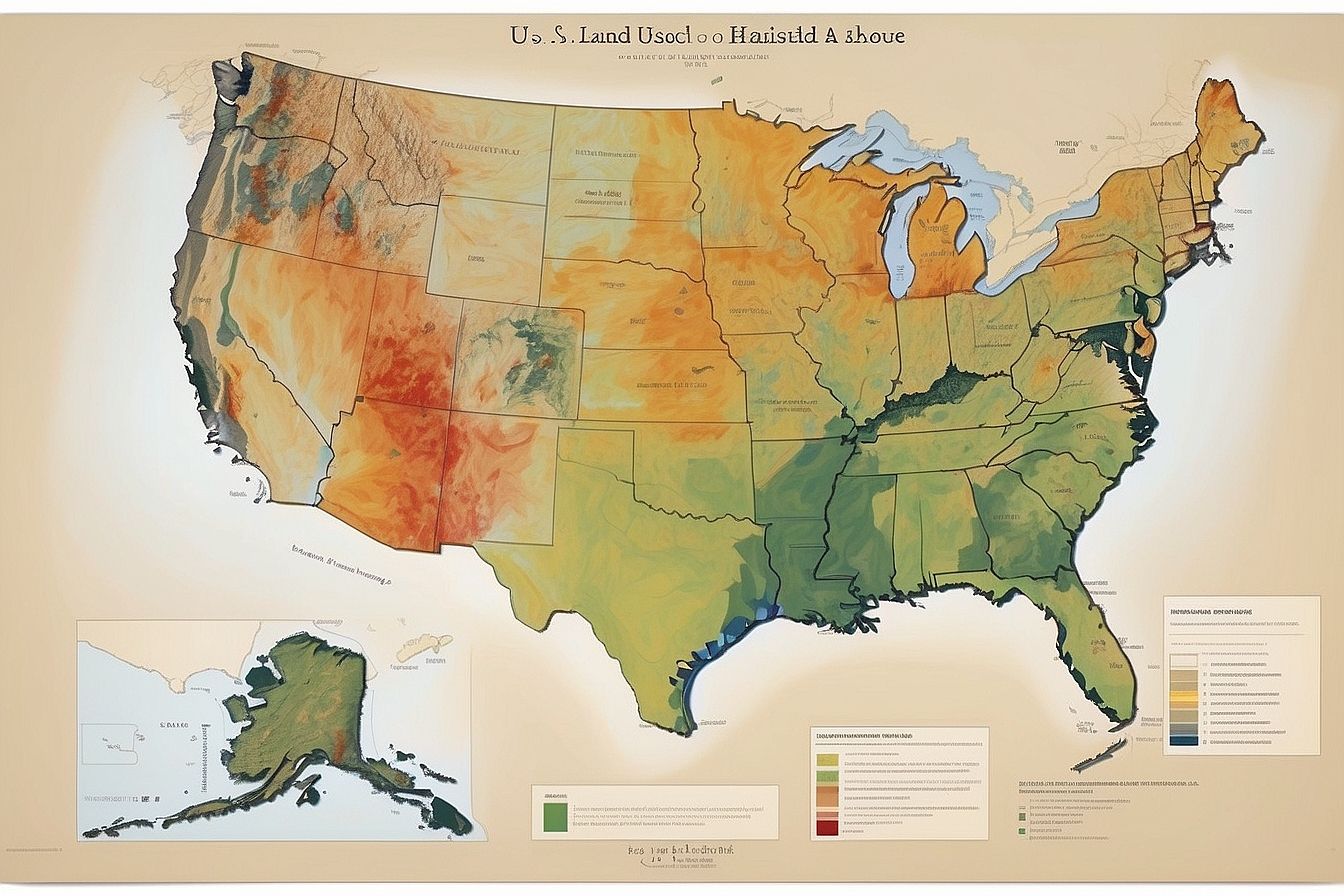We’re all too familiar with the pressure to find ways to utilise land without causing harm to our precious planet. As conscientious custodians of Earth, your concerns resonate deeply with us, and so we’ve delved into extensive research.
What’s emerged is quite striking: over half of the world’s habitable land is currently consumed by agriculture. Our forthcoming article shines a spotlight on creative approaches that strike an essential harmony between satisfying human necessities and preserving environmental wellbeing.
Join us as we venture through enlightening discussions towards cultivating a sustainable future!
Key Takeaways
- Global population growth is leading to land scarcity, making it crucial to manage our limited space for agriculture, housing, industry, and natural habitats responsibly.
- Current unsustainable land use practices are causing soil degradation, deforestation, and loss of biodiversity, all of which contribute to climate change and impact the planet’s ecosystems negatively.
- Sustainable land management involves balanced approaches that integrate economic growth with social equality and environmental conservation in order to protect resources for future generations.
- Around the world there are shining examples where sustainable land use has been successful such as agroforestry in Ghana improving soil fertility or wetland restoration in the US aiding flood protection while enhancing biodiversity.
- By learning from these positive case studies and promoting integrated methods that consider varied needs we can move towards more resilient and adaptable systems safeguarding a healthier environment.
Challenges of Current Land Use Practices
Current land use practices face challenges such as land scarcity and the unsustainable use of resources, leading to a negative impact on the environment. These issues require urgent attention and sustainable solutions to ensure the well-being of future generations.
Land scarcity
We find ourselves facing a critical issue with land scarcity as the global population continues to surge. Limited space must support agriculture, housing, industry, and natural habitats all at once.
We see that our available land is not infinite; we must act responsibly to ensure it meets the needs of both present and future generations.
Intensive farming practices and expanding urban areas are consuming large swaths of arable land at an alarming rate. As stewards of the Earth, we recognise that sustainable land use planning is essential for maintaining biodiversity conservation, ensuring agricultural sustainability, and addressing climate change mitigation.
We advocate for smarter growth strategies that preserve valuable ecosystems while meeting social and economic demands. By prioritising environmental stewardship in our development plans now, we secure more than just soil health; we safeguard a legacy of ecological sustainability for years to come.
Unsustainable use of land resources
Unsustainable use of land resources has detrimental effects on our environment and ecosystems. Overexploitation, deforestation, and poor agricultural practices lead to soil degradation, loss of biodiversity, and reduced ecosystem services.
This impacts not only the natural world but also jeopardises the sustainability of agricultural production and water management systems. Furthermore, unsustainable urban development contributes to the destruction of natural habitats and exacerbates climate change by increasing carbon emissions.
To address these challenges, it is crucial to promote sustainable land management practices that prioritise environmental conservation alongside economic and social considerations.
Integrated approaches that emphasise resource management, land conservation, and biodiversity protection are essential for preserving ecosystem services and maintaining soil health.
Negative impact on environment
The unsustainable use of land resources has led to a negative impact on the environment, affecting ecosystems and natural resources. Soil degradation, deforestation, and loss of biodiversity are just some of the consequences resulting from current land use practices.
Climate change is exacerbated by these activities, further impacting the delicate balance of our planet’s ecosystems. In order to ensure environmental sustainability and preserve our natural resources for future generations, it is crucial to shift towards more sustainable land use practices that prioritise ecosystem preservation and climate change mitigation.
Furthermore, overexploitation of renewable resources has contributed to irreversible damage in many regions. This underscores the urgent need for integrated approaches that consider soil health and comprehensive natural resource management.
The Future of Sustainable Land Use
We need to find a balance between economic, social, and environmental considerations when it comes to land use. Integrated approaches that take all of these factors into account are crucial for the future sustainability of our land use practices.
Successful examples and case studies can provide valuable insights into how we can achieve this balance effectively.
Balancing economic, social, and environmental considerations
To achieve sustainable land use, we must balance economic, social, and environmental considerations. This means finding solutions that benefit people, the planet, and prosperity. It involves assessing the impact of our actions on ecosystems while ensuring fair opportunities for all members of society.
Striking this balance enables us to foster healthy communities, promote resilience in the face of climate change, and protect vital habitats.
When considering sustainable land use strategies, we must integrate economic development with social well-being and environmental conservation. By doing so, we can create thriving economies while safeguarding natural resources for future generations.
Importance of integrated approaches
Integrated approaches are vital for achieving sustainable land use. By considering economic, social, and environmental aspects together, we can develop solutions that benefit all areas.
This approach ensures that actions taken to improve land use have positive effects across the board, promoting balanced and comprehensive outcomes.
Integrated approaches allow us to address complex challenges with a broader perspective. By coordinating efforts across different sectors and stakeholders, we can create more effective strategies that promote sustainable land use while accounting for various needs and considerations.
Successful examples and case studies
We can see successful examples and case studies of sustainable land use in action, demonstrating the positive impact of integrated approaches. Let’s look at some remarkable instances:
- The expansion of agroforestry in Ghana has not only improved soil fertility but also provided additional income for local farmers by diversifying their produce.
- The implementation of wetland restoration projects in the United States has not only enhanced biodiversity but also provided natural flood protection, benefiting both ecosystems and nearby communities.
- The adoption of regenerative agriculture techniques in Australia has not only increased soil health but also reduced greenhouse gas emissions, contributing to climate change mitigation efforts.
- The establishment of community – managed marine protected areas in the Philippines has not only revived fish populations but also boosted local economies through sustainable ecotourism initiatives.
- The promotion of sustainable urban planning in Denmark has not only reduced pollution but also created vibrant and livable cities, improving the quality of life for residents.
- The restoration of degraded grasslands in Mongolia has not only preserved traditional nomadic lifestyles but also safeguarded wildlife habitats, promoting conservation and sustainable land use practices.
Conclusion
In conclusion, sustainable land use requires balancing economic, social, and environmental considerations. Integrated approaches are crucial for long-term success. Learning from successful examples and case studies can guide us toward a more sustainable future.
It’s time to embrace change and work towards a healthier planet for all.
FAQs
1. What does sustainable land use mean for the future?
Sustainable land use involves managing our lands to meet social and economic needs while protecting the environment for generations to come.
2. How will social considerations affect sustainable land use?
Social considerations ensure that the benefits of land resources are shared fairly, supporting community well-being and considering people’s lifestyles in a sustainable future.
3. Can economic growth go hand in hand with sustainable land use?
Yes, with careful planning, we can design ways to use our lands that drive economic growth without harming the environment, ensuring sustainability long term.
4. Why is it important to focus on sustainable land use now?
Focusing on sustainable land use helps prevent damage to ecosystems and ensures that our natural resources can support all living things now and in the future.





